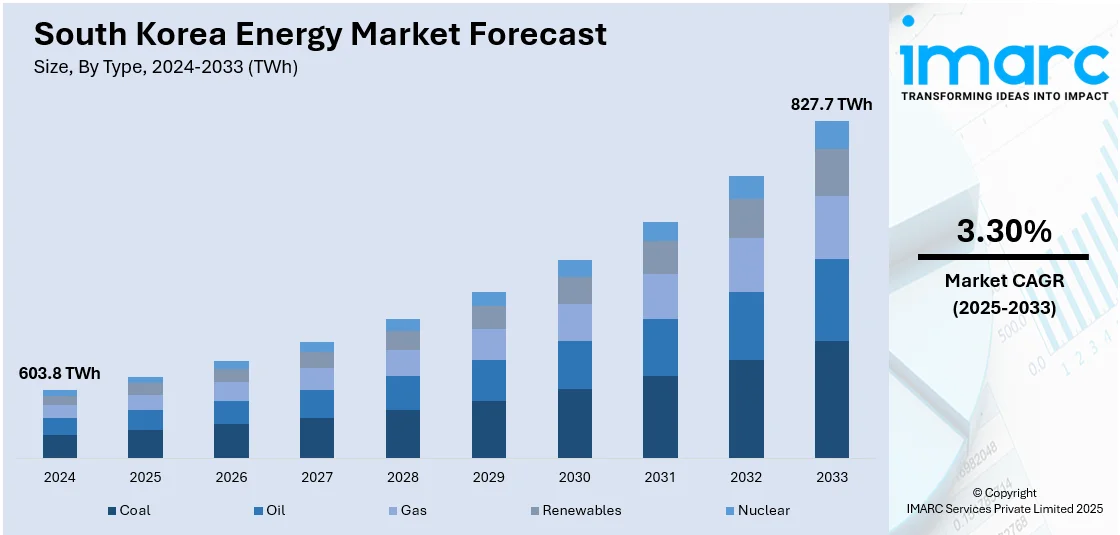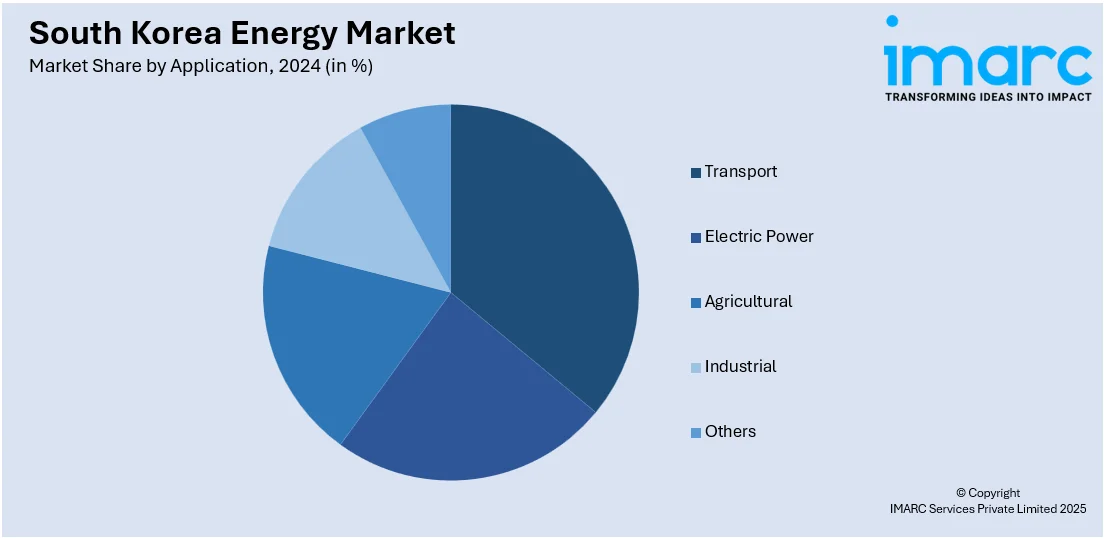
South Korea Energy Market Size, Share, Trends and Forecast by Type, Application, and Region, 2025-2033
South Korea Energy Market Size and Share:
The South Korea energy market size reached 603.8 TWh in 2024. Looking forward, IMARC Group expects the market to reach 827.7 TWh by 2033, exhibiting a growth rate (CAGR) of 3.30% during 2025-2033. The market is experiencing significant growth driven by strong push toward renewables, nuclear expansion, and cleaner technologies. Policy reforms, energy security goals, and decarbonization efforts are further shaping future investments and diversifying the country’s overall energy mix.
|
Report Attribute
|
Key Statistics
|
|---|---|
|
Base Year
|
2024
|
|
Forecast Years
|
2025-2033
|
|
Historical Years
|
2019-2024
|
| Market Size in 2024 | 603.8 TWh |
| Market Forecast in 2033 | 827.7 TWh |
| Market Growth Rate 2025-2033 | 3.30% |
South Korea Energy Market Trends:
Shift Toward Renewable Energy
South Korea is accelerating its transition toward renewable energy as part of its broader strategy to reduce dependence on fossil fuels and lower carbon emissions. This shift is the main driver of South Korea energy market growth, reshaping the country's energy mix and investment landscape. Solar and wind power are receiving increased support through government-backed incentives, while hydrogen is emerging as a major pillar of clean energy development. Infrastructure upgrades, such as smart grids and energy storage systems, are being rolled out to support the integration of intermittent renewables. The government’s long-term carbon neutrality goals are prompting utilities and private sector players to pivot toward greener alternatives. Reflecting this momentum, significant foreign investment is being directed toward large-scale renewable projects. For instance, in March 2025, Vena Energy announced a major investment in South Korea's renewable energy sector, including $300 million for the 384MW Yokji Offshore Wind Project in South Gyeongsang Province. The project aims to enhance energy security and carbon neutrality while fostering local partnerships and economic benefits. Construction of the 500MW Taean Offshore Wind Project is set for next year. This trend is also influencing domestic manufacturing, R&D, and international collaboration. The ongoing push for clean energy diversification is expected to strongly shape the South Korea energy market outlook in the coming years.

Nuclear Energy Expansion
South Korea is reinforcing its commitment to nuclear energy as a key part of its strategy to ensure energy stability and meet climate goals. For instance, in February 2025, South Korea’s Ministry of Trade, Industry and Energy announced an increase in financial support for its nuclear industry, providing KRW150 billion this year. This follows a commitment to sustain nuclear power's share in the energy mix at 30% by 2030 and plans for the construction of Shin Hanul units 3 and 4. Nuclear power is viewed as a reliable, low-emission alternative to fossil fuels, capable of supporting base-load electricity demands without the variability seen in renewables. The government is not only extending the life of existing reactors but also restarting paused construction and planning new projects. Nuclear technology exports are also being prioritized, with South Korea aiming to become a global player in reactor development. Public and political support for nuclear has grown, especially as energy security becomes more critical. Investment in workforce development and safety upgrades further underlines its long-term role in the country’s energy mix. These moves are set to maintain and potentially increase nuclear’s contribution to the South Korea energy market share over the coming years.
South Korea Energy Market Segmentation:
IMARC Group provides an analysis of the key trends in each segment of the market, along with forecasts at the regional level for 2025-2033. Our report has categorized the market based on type and application.
Type Insights:
- Coal
- Oil
- Gas
- Renewables
- Nuclear
The report has provided a detailed breakup and analysis of the market based on the type. This includes coal, oil, gas, renewables and nuclear.
Application Insights:

- Transport
- Electric Power
- Agricultural
- Industrial
- Others
A detailed breakup and analysis of the market based on the application have also been provided in the report. This includes Transport, Electric Power, Agricultural, Industrial and Others.
Regional Insights:
- Seoul Capital Area
- Yeongnam (Southeastern Region)
- Honam (Southwestern Region)
- Hoseo (Central Region)
- Others
The report has also provided a comprehensive analysis of all the major regional markets, which include Seoul Capital Area, Yeongnam (Southeastern Region), Honam (Southwestern Region), Hoseo (Central Region) and others.
Competitive Landscape:
The market research report has also provided a comprehensive analysis of the competitive landscape. Competitive analysis such as market structure, key player positioning, top winning strategies, competitive dashboard, and company evaluation quadrant has been covered in the report. Also, detailed profiles of all major companies have been provided.
South Korea Energy Market News:
- In March 2025, Recurrent Energy, alongside 3M Korea and local leaders, signed a Carbon Neutrality Agreement at the 2025 Capital Region Investment Roadshow. The partnership focuses on developing a 200MW solar power plant in Naju City, promoting decarbonization, job creation, and sustainable energy independence in South Korea.
- In February 2025, the South Korea government announced its plans to construct two large nuclear reactors and a small modular reactor by 2038, aiming for carbon-free power generation to reach 70% of its energy mix. The country plans to increase renewable energy to 7 GW yearly and significantly reduce coal power generation by 2038.
South Korea Energy Market Report Coverage:
| Report Features | Details |
|---|---|
| Base Year of the Analysis | 2024 |
| Historical Period | 2019-2024 |
| Forecast Period | 2025-2033 |
| Units | TWh |
| Scope of the Report |
Exploration of Historical Trends and Market Outlook, Industry Catalysts and Challenges, Segment-Wise Historical and Future Market Assessment:
|
| Types Covered | Coal, Oil, Gas, Renewables, Nuclear |
| Applications Covered | Transport, Electric Power, Agricultural, Industrial, Others |
| Regions Covered | Seoul Capital Area, Yeongnam (Southeastern Region), Honam (Southwestern Region), Hoseo (Central Region), Others |
| Customization Scope | 10% Free Customization |
| Post-Sale Analyst Support | 10-12 Weeks |
| Delivery Format | PDF and Excel through Email (We can also provide the editable version of the report in PPT/Word format on special request) |
Key Questions Answered in This Report:
- How has the South Korea energy market performed so far and how will it perform in the coming years?
- What is the breakup of the South Korea energy market on the basis of type?
- What is the breakup of the South Korea energy market on the basis of application?
- What is the breakup of the South Korea energy market on the basis of region?
- What are the various stages in the value chain of the South Korea energy market?
- What are the key driving factors and challenges in the South Korea energy market?
- What is the structure of the South Korea energy market and who are the key players?
- What is the degree of competition in the South Korea energy market?
Key Benefits for Stakeholders:
- IMARC’s industry report offers a comprehensive quantitative analysis of various market segments, historical and current market trends, market forecasts, and dynamics of the South Korea energy market from 2019-2033.
- The research report provides the latest information on the market drivers, challenges, and opportunities in the South Korea energy market.
- Porter's five forces analysis assist stakeholders in assessing the impact of new entrants, competitive rivalry, supplier power, buyer power, and the threat of substitution. It helps stakeholders to analyze the level of competition within the South Korea energy industry and its attractiveness.
- Competitive landscape allows stakeholders to understand their competitive environment and provides an insight into the current positions of key players in the market.
Need more help?
- Speak to our experienced analysts for insights on the current market scenarios.
- Include additional segments and countries to customize the report as per your requirement.
- Gain an unparalleled competitive advantage in your domain by understanding how to utilize the report and positively impacting your operations and revenue.
- For further assistance, please connect with our analysts.
 Request Customization
Request Customization
 Speak to an Analyst
Speak to an Analyst
 Request Brochure
Request Brochure
 Inquire Before Buying
Inquire Before Buying




.webp)




.webp)












